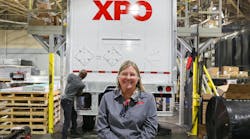Despite a strong run-up in Class 8 sales this year, accompanied by a still-significant backlog of orders, fleets remain largely focused on only using newly purchased units to replace older equipment – not to expand their operations with additional capacity.
“What we’ve really seen this year is the ‘perfect storm’ if your will for the Class 8 market,” Eric Starks, president of FTR Associates, told Fleet Owner. “The age of the U.S. trucking fleet is the oldest it’s ever been, a lot of large carriers had cash on hand, decent freight volumes combined with tight capacity pushed up rates, and the ability to depreciate new assets 100% this year combined to drive up orders and sales.”
But Starks stressed that the heightened order rate this year only reflects the desire by fleets to replace older trucks, not add capacity. The softening U.S. economy combined with high fuel prices this year, “has created a lot of edginess throughout the freight system,” he said. “Many carriers are sticking with a wait-and-see approach before committing to expand their fleets.”
Data from the Second Quarter Business Expectation Survey compiled by Transport Capital Partners (TCP) backs up that view, with many carriers pointing to “inadequate returns on investment” as a major factor stifling reinvestment in new equipment.
Only 53% of carriers overall surveyed by TCP responded that they are getting a rate of return on their investment adequate enough to justify reinvesting in equipment, with only 45% of smaller carriers (defined as generating under $25 million in revenues) believing they are receiving adequate returns compared to 57% of their larger counterparts.
“The recent large increases in Class 8 orders is truly pent-up demand for replacements to mitigate maintenance costs and potential down time,” Richard Mikes, TCP partner and the survey’s founder. That’s why he believes over the last few years there’s been a significant drop in truly “new equipment” purchasing.
“Even though 86% of the carriers in this quarter’s survey said they have access to reasonable credit, the concern over inadequate returns on capital is a choke point in adding capacity and unless rates adjust to cover rising costs, capacity will be restrained,” added Lana Batts, another TCP partner.
Steven Dutro, another of TCP’s principles, said that the firm’s survey also indicates more interest among carriers in reviewing trade cycles, new equipment economics and strategically addressing alternative financing structures and leverage issues.
As an example of lengthening trade cycles, FTR’s Starks pointed to the significant increase in average Class 8 age over the last two decades. In 2000, the firm’s research indicated average the Class 8 truck hovered around 8.12 years old; by 2010, it had jumped to over 9.43 years and is expected to pass the 9.5 mark by the end of 2011.
The age factor alone is what’s driving much of the surge in new truck orders and sales. As a result, FTR expects total North American Class 8 factory shipments to top 259,000 units this year and surpass 299,000 units in 2012 – a significant increase over the 153,969 units shipped in 2010.
Indeed, the backlog in Class 5 through 8 orders for the North American market remains strong, despite a 1% drop during June, according to data collected by ACT Research Co. This “easing” represents the second straight month of slower order activity, as net orders came in at 21,266 units during June, a 9% drop from May.
“Despite the slowing in new-order activity over the last couple of months, it is important to note that the industry backlog continues to be very solid,” noted Kenny Vieth, ACT’s president and senior analyst. “Cancellations continue to be very low, an indication of the quality of the orders currently booked with truck manufacturers.”




